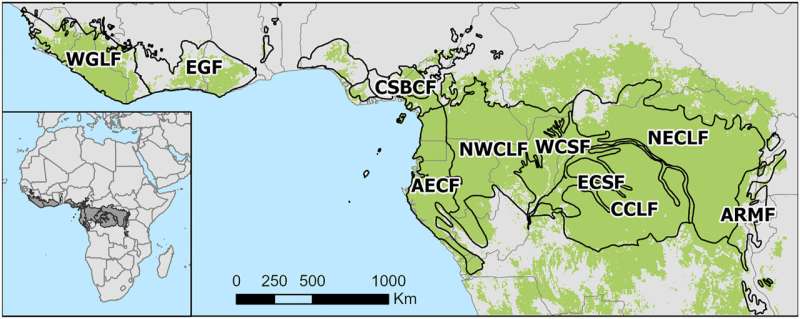
Study area encompassing locations with>50% forested land cover (green shading) falling within the Tropical and Subtropical Moist Broadleaf Forests of West and Central Africa (Black Lines). The 10 ecoregions with the highest area of forest land cover are labeled. AECF = Atlantic Equatorial Coastal Forests; ARMF = Albertine Rift Montane Forests, CCLF = Central Congolian Lowland Forests, CSBCF = Cross-Sanaga-Bioko Coastal Forests, ECSF = Eastern Congolian Swamp Forests, EGF = Eastern Guinean Forests, NECLF = Northeastern Congolian Lowland Forests, NWCLF = Northwestern Congolian Lowland Forests, WCSF = Western Congolian Swamp Forests, WGLF = Western Guinean Lowland Forests. Credit: Geophysical Research Letters (2024). DOI: 10.1029/2023GL106240
A new study presents the first large-scale analysis of fire patterns in West and Central Africa’s wet, tropical forests. The number of active fires there typically doubled over 18 years, particularly in the Congo Basin. The increases are primarily due to increasingly hot, dry conditions and humans’ impact on the forests, including deforestation. The increase in forest fires is likely to continue given current climate projections, according to the study.
With fires increasing in other historically wet forests, such as the U.S. Pacific Northwest and the Amazon, wet forest fires can no longer be ignored, the researchers say.
Scientists have known for decades that wet forests in western and central Africa have fires, but because the fires tend to be much smaller than their counterparts in dry woodlands and savannas, relatively little research has been done on Africa’s tropical forest fires. This has led to uncertainty over where and when they burn, what exacerbates them and how that might shift in response to climate change.
“Historically, scientists have not considered fire to be an important part of wet, tropical forests, but there’s been work in the Amazon in recent decades that has suggested otherwise,” said Michael Wimberly, an ecologist at the University of Oklahoma who led the study. “We need to start thinking about wet forests as being susceptible to fires and considering fire an important impact of climate change in tropical forests.”
The study was published in Geophysical Research Letters.
Drier forests, frequent fires
Previous research on fires in wet, tropical African forests has typically focused on relatively small areas or used datasets that were not representative of the whole forest system. Wimberly’s new study is the first comprehensive assessment of fire patterns in wet African forests, which are mostly ignited by humans.
The researchers used satellite imagery to track active fires from 2003 to 2021 in western and central Africa, including the Congo Basin. The researchers found an unambiguous increase in fire frequency over time. The greatest increases were in the Northwest Congolian Lowland Forests, where there were 400 more active fires per 10,000 square kilometers (3,861 square miles) annually in 2021 as compared to 2003. Across most of the Congo Basin, active fire densities typically doubled over the study period.
Areas with rapid forest loss, or deforestation, also saw more fire activity. Deforestation is associated with high levels of human activity and fragments of the remaining forests, increasing the length of exposed edges where most fires burn. A forest’s edge has a drier microclimate and more invasive species than interior forests, making it more susceptible to fire.
The researchers also compared fire occurrences to weather patterns and found clear associations between fires, high temperatures, and vapor pressure deficit, which is an indicator of plant water stress. They found a particularly strong relationship during the 2015-2016 “super El Niño,” which brought anomalous heat and drought conditions to tropical Africa.
“I was surprised at how strong and clear the climate signal was,” Wimberly said.
The findings provide critical insights into how climate change could influence African forest fire activity, particularly during El Niño years, and highlight the need to control fires at forests’ edges to prevent harmful feedback loops: A fire-affected forest is more likely to have less canopy cover and more fragmentation, increasing its fire risk.
“Tropical forest fires have been long overlooked, but they’re only going to become more important in the future,” Wimberly said. “We can’t ignore them any longer.”
More information:
M. C. Wimberly et al, Increasing Fire Activity in African Tropical Forests Is Associated With Deforestation and Climate Change, Geophysical Research Letters (2024). DOI: 10.1029/2023GL106240
Citation:
Wildfires in wet African forests have doubled in recent decades, large-scale analysis finds (2024, May 2)
retrieved 2 May 2024
from https://phys.org/news/2024-05-wildfires-african-forests-decades-large.html
This document is subject to copyright. Apart from any fair dealing for the purpose of private study or research, no
part may be reproduced without the written permission. The content is provided for information purposes only.
>>> Read full article>>>
Copyright for syndicated content belongs to the linked Source : Phys.org – https://phys.org/news/2024-05-wildfires-african-forests-decades-large.html
